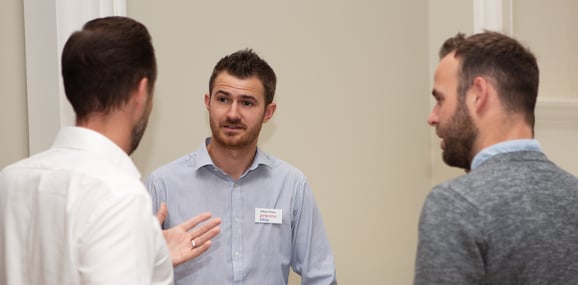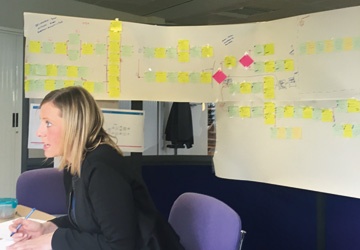I think that the first time I was called the change guy, it was a thinly-veiled insult. “OK everybody listen up. This is Alan; he’s the change guy. He’s gonna help us change.” The implication was that management had hired me and I was there to change a recalcitrant workforce. Of course, that’s nonsense, it is impossible to change someone else - that’s one of the reasons the divorce rate is as high as it is.
This article explores the following. Please do feel free to skip straight to a specific section.- What is Organisational Change?
- Making Sense of Change Management
- Innovate-Integrate-Improve-Integrate-Repeat
- Business is About People
- 6 Tips to Create Organisational Change in an Organisation
- Some Practical Help
What is Organisational Change?
I want to dispel some myths about organisational change, impart how I have come to make sense of change management and help you understand how you can implement strategic change management in your own organisation.
Over my 40 or so years in this business, I have worked for 5 consulting firms and as an independent alongside consultants from the big strategy firms. Calling me the “change guy’ is the kind of sneer that used to be typical from content consultants who regarded anyone who worked with people and culture as useless. “Here’s Alan, the change guy. The competition is eating your lunch and your company is going bankrupt. He’s gonna ask you how you 'feel' about that.” While emotions can drive performance, I don’t focus on them. Instead, I work with the processes and structures that enable positive results.
But times have changed. Tough line managers used to make fun of culture; “You mean the little white plastic tubs of sour milk in the fridge?” Now everybody sounds like an organisational development guru, “We’re on a journey to mould our environment to produce the optimum customer experience.”
Change managers used to be what the big systems integrators called the user interface trainers who came in at the end of a big system implementations to "show the dummies which button to push." Now if you google 'Change Management', you’ll come up with literally hundreds of certification courses.
I am grateful to have worked in this field long enough that at least now people use the words change management without curling their upper lip. I have even begun to self-describe as a “change guy” and I know one consultant who proudly calls herself “the change lady.”
Making Sense of Change Management
Some years ago, I crafted my tag line: "Helping leaders make strategic change", to describe where my work almost always started. I would be hired to facilitate a group, sometimes the C-suite leadership team, sometimes an extended leadership group and my job was to get them on the same page about a new initiative.
The initiative could be a new strategy or organisation design. The company might need new products or to make more money with the same resources.
The process of this work was often similar. I would interview people all over the firm to determine their views about the need for change and their ideas about what to do. There would be meetings where I would feed back the different points of view. We’d accept the 'points of agreement', and spend our time on the 'points of discussion' (I never call them disagreements because I found such language hardens people’s positions).

If you do not have the time to interview people, or find that they do not answer you honestly when you do, Ask The Crowd is a great way to harvest your teams change ideas. Your team (and customers) can submit change requests in the form of inputs, which other users can vote on, so you know which are the most - and least! - popular change ideas.
Once we had come to public agreement, we plan actions on the change. I called this service offering Leadership Alignment. If it extended to redesigning the organisational structure, processes, or systems, I’d call it Organisational Alignment or integration. One client once called leadership alignment 'herding cats', and me CHIC (cat-herder in chief) - I know how the comedian Rodney Dangerfield felt; “I don’t get no respect, you-know-what-I-mean?”
I have a colleague who says “the thing about change management is that nothing happens unless someone actually does something differently.” Getting people to agree to take action and then gently helping them follow through is more than half the battle.
Most of my work centres around implementing two key processes:
- How a company innovates
- How they improve
I’ve come to believe that these two processes are ends of a continuum that underpin the health of any organisation.
Innovate-Integrate-Improve-Integrate-Repeat

Innovation starts a business cycle; we create or reinvent something. We perceive an unmet customer need or we discover a new technology that has use in our business. This leads to an idea that we can develop and then test and implement.
Then we have to integrate the new product, market entry or operating process with our core business.
Later in the cycle when some element is under performing or missing an opportunity, we measure where we are and make a plan to improve and measure again to quantify the improvement. Then we have to integrate the improvements with our core business and repeat the improvement process until the magnitude of the change needed requires innovation again.
Growth in revenue and profit comes down to how well a business innovates, integrates and improves continuously. There are other parts to organisational change management such as training and education, organisation design and understanding incentives but an aspiring change manager should master this connected process.
Business is About People
My undergraduate degree is in theatre. I studied people at first because I wanted to portray them as an actor, but the habit I developed proved to be quite helpful as a change consultant. Later I waited tables, tended bar, drove a cab, worked night shifts in factories to leave my days free for auditions - more opportunities to observe.
Here are four things I learned from the theatre that are useful in everyday life:
- Immerse Yourself in Human Behaviour - Find ways to develop empathy for the working person
- No Experience is Wasted if you can analyse and learn from it - Bring your entire life to your work
- Stars will always under perform in the ensemble – when you’re part of the cast there are no small parts – only small actors
- Presentations always require rehearsals

My first job after giving up acting was as a booking agent. I arranged personal appearances for Ralph Nader, Margaret Mead, Ross Perot, congress people, comedians and movie stars on the lecture circuit - first at colleges, then later at business conferences.
Here is what I use from that experience and others in my crazy career:
- People Are People – whether talking with a student lecture chairman or someone whose fame tongue-ties you, I learned that people want to be listened to first
- Customers Have Needs - if you ask them they’ll tell you how to please them
- Successful Change is About Leadership - while I was studying for my MBA at the London Business School, I was hired to work on two consulting projects. A year later when I revisited these chief executives, the one who had engaged directly with the team implemented our recommendations. The CEO who delegated the project to a flunky still had the now-dusty report on his credenza but had done nothing
- Skill at Training, Design and Facilitation is a Good Foundation for Change Work - I sold management and sales training for the Forum Corporation and learned how to design and do stand-up training. I use these skills a lot
- Learning by Doing is the Fuel of Change – for ten years, I worked behind Dr. George Litwin, author of Motivation and Organisational Climate - one of the leading lights of the organisational development field. George had a habit of throwing me in the deep end so I would learn to swim or die. Painful yes, and more than a bit scary at times, but I’ve learned more by doing than I have in the many short courses I’ve taken
6 Tips to Create Organisational Change in an Organisation
There are many roles in this field. Perhaps you are considering leading an organisational change project in your firm - maybe you are an internal change consultant (like a Lean Six Sigma Black Belt). Maybe you work for an external consulting firm and would like to practice large scale change. Each will require different competencies; the combination of knowledge and skill.
Here are a few ideas that will fit across all roles:
- Understand the Business – Organisational change is about getting a business result. Learn how the company makes money, what customers want, what suppliers can contribute, what the constraints of operations are, then you can communicate the “why of change” and you are more likely to deliver a result that matters.
- Connect to People – Work on developing your empathy gene by talking with customers, suppliers, leaders and line workers - people across all parts of the business. Find ways to be helpful, share credit and build trust by always doing what you promise.
- Develop Process Focus – What is value to the customer and what activities are needed to deliver it (and in what order).
- Experiment Enthusiastically – Both innovation and improvement are based upon the scientific method: state the problem including the facts and measurements; make a hypothesis as to cause and solution; test it, try it then fix it and try it again and document both success and failure. Apply this to your work and your own development.
- Learn, Baby, Learn – Learn the levers of organisational change, organisational structure, training, systems, or processes like innovation and improvement. Find ways to expose yourself to serendipity, get off the train at another stop, read a book you think you’ll hate or talk to someone who is different from you. Take the time to reflect .Write down what you are learning and what you’d like to learn next.
- Always, Always be Authentic – If the “little voice in the back of your head” is ever saying something different from the words coming out of your mouth, STOP. Get back to the truth. The only thing you have to offer to this work is you.
In the words of Mahatma Gandhi “Be the change you want to see in the world.”
Some Practical Help
Triaster's Ask The Crowd platform is a software tool that is designed to capture everyone's ideas and prioritisation views to enable you to build the best possible change roadmap that everyone can get behind. It also takes care of much of the communication needed to build a culture of Continuous Improvement and helps you to streamline the change process, taking users step by step through the actions required of them.
If you are serious about becoming a 'change guy' and creating a culture of Continuous Improvement, you should sign up for a free trial of the ATC Platform now.
Related Articles
How we Improved our Software Development Process with Ask The Crowd
Change Management vs Continuous Improvement: Which is best for you?
Business Process Improvement: Understanding the Impact of Change
Written by Alan Cay Culler
Alan Cay Culler is a management consultant with 40 years or so of experience, specializing in strategic leadership and change. Alan has worked with name clients in many industries. He has taught in executive education programs at several universities including The Wharton School, Carnegie Mellon University and the University of Pittsburgh. Alan has worked for 5 consulting firms including Gemini Consulting where he rose to be the head of the leadership and organisational practice, and Katzenbach Partners, a start-up, McKinsey spinoff, which combined strategic analytics with organisational consulting. In 2014 Alan founded The Results-Alliance, a confederation of independent consultants and small firms that help companies implement sustainable change, mostly through initiaves of integration, innovation and continuous improvement, www.results-alliance.com





